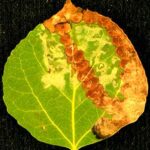Ink Spot
Ink spot is a fungal disease that affects various plant species, including fruit trees, ornamental trees, and shrubs. It is caused by the fungus Alternaria alternata, which can survive in plant debris and soil for long periods. The disease is characterized by the appearance of small, circular or irregularly-shaped spots on leaves, stems, flowers, and fruit, which may coalesce and form large necrotic areas.
The spots caused by ink spot are often brown or black, and may be surrounded by a yellow halo. The leaves may become distorted and twisted, and the affected plant may exhibit stunted growth. In severe cases, defoliation can occur, which can weaken the plant and reduce its vigor.
The fungus that causes ink spot overwinters in plant debris and soil, and is spread by wind, rain, and irrigation. The disease is most common in humid and wet conditions, and can be more severe on plants that are stressed due to drought or other factors.
Prevention and control of ink spot involves maintaining good sanitation practices, such as removing fallen leaves and pruning infected branches. Fungicides may also be used to control the disease, although they are most effective when applied early in the growing season before symptoms appear. Some cultural practices, such as reducing irrigation during humid conditions and providing proper plant nutrition, can also help to reduce the incidence of the disease.
In summary, ink spot is a fungal disease that affects a wide variety of plant species, and is characterized by the appearance of circular or irregularly-shaped black or brown spots on leaves, stems, flowers, and fruit. Good sanitation practices, cultural management, and fungicides can help prevent and control this disease.



